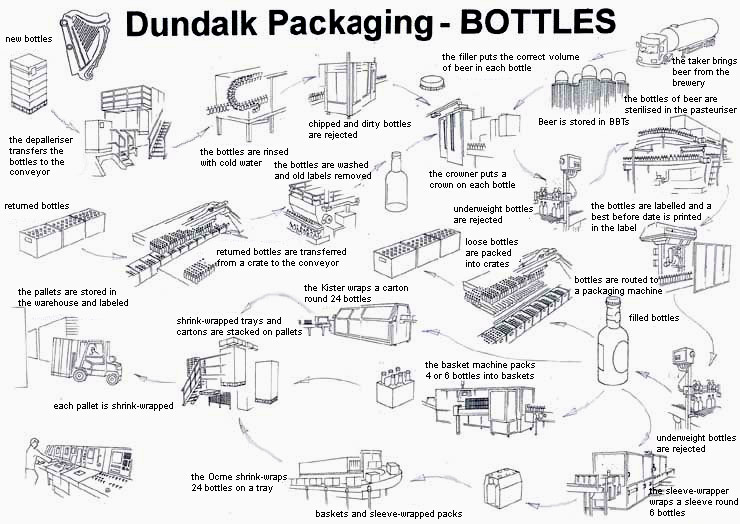The Bottling Process

Tanker Intake
The beer tanker brings the pasteurised beer from the brewing plant and the beer is kept at a constant temperature.
Bright Beer Tank
The beer which has been transported from the brewing plant is tested and if it meets the stringent standards is pumped into huge Bright Beer Tanks(BBT’s) which could hold up to 1100 hectoliters.
The Crowner
This machine was used to put the bottle tops or “crowns” on each bottle. It could process up to 800 bottles per minute placing a generic bottle cap pressurised to 120 psi with a plastic inlay on every single bottled product. The machine used a mechanical crimping mechanism to sealed each metal cap on to of the bottle.
The Bottle Labeller
This machine applies multiple labels to the front, back and neck of every bottle using a special non-toxic glue. It was capable of applying up to 800 three label combinations on every bottle at speed no matter what the bottle size. There were over 140 label type and design’s which corresponded to the domestic and export products. A spring loaded magazine was loaded with a stack of 80 gramme labels which were applied at speed with the help of a non-toxic glue.
The Empty Bottle Inspector
This high tech machine examined up to 50,000 bottle per hour using x-ray technology to ensure that foreign bodies had not entered any bottles before the beer was filled. Every second, the base, neck and sidewall of each bottle was examined and rejected if an imperfection was found.
The Pasteuriser
This is where the bottled beer was heated in a selected range from 20 – 60 degrees in order kill off any bacterial elements that occur naturally as part of the brewing process. A combination of steam and high pressure water jets were used in this process and up to 50,000 bottles could be pasteurised at any one time.
The Decrater
This machine was used to automatically remove used or returned bottles from plastic cases coming from the the trade. They would be placed on conveyor line ready for label removal and washing.
The Washer
After the bottles were decrated they would enter a high pressure washer. This machine used a combination of heat and high pressure water jets to remove the sticky labels from each bottle as it passed through.
The Depalletiser
This area was used to convey brand new bottles from the glass supplier onto the production line ready for washing. It was vital that the correct bottle type was loaded to the line so that each individual beer could be packaged into its trade mark bottle.
The Rinser
This machine was used to gently rinse new bottles so that loose glass fragments or dust particles could be removed before they could be more thoroughly inspected by the E.B.I.
The Filler
Many say this machine was the at the heart of the Bottling Operation as it actually filled each bottle accurately at a very high speed. This machine was capable of filling in excess of 60,000 bottles per hour through a rotation mechanism which raised each bottle up to a filling nossle.
The Full Beer Inspector
This machine was used to ensure that the correct volume of beer was put into every single bottle. It was critical to ensure that the same level of beer was put into every bottle for customer equability reasons. Under filled or overfilled bottles were rejected by this machine.
The Crater
Most of the bottles sent to pub outlets are carried in plastic crates and this machine lifted up to 96 bottles at a time placing them into individual cases.
The Basket Packer
This machine placed sets of 4 or 6 bottles together into cardboard baskets which will already have the product logo or brand name and colouring.
The Kister Machine
This machine is a variation of the Basket Packer as it managed to wrap a cardboard carton around and entire case of bottles which was usually 24 bottles in total.
The Shrink Wrapper
This complicated machine applies a coating of shrink wrap plastic around a pallet of stacked trays of cartons. It circled the pallet using plastic under tension to apply a strong and safe packaging to each pallet.
Forklift Transport
A forklift is finally used to transport a single shrink wrapped pallet from the end of the production line to a pre-assigned location in the Warehouse Loading Bay. From here the finished product would be transported all over Ireland and Worldwide.
The OCME Machine
This machine applied a tight shrink wrapped layer of see through plastic to each tray of beer. Application of heat would seal the plastic completely around the case.
The Sleeve Wrapper
This machine automatically wrapped a cardboard sleeve around six bottles which would have the product name, logo and colour scheme.
